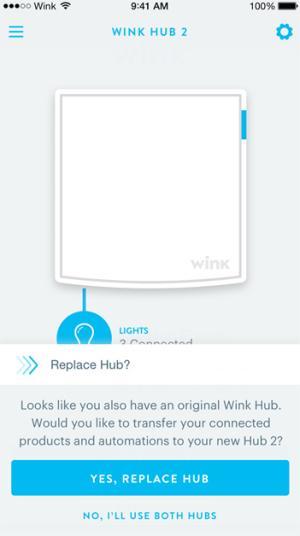After being sold by bankrupt parent company Quirky last year, it’s good to see that Wink is still alive and kicking. The Wink Hub 2 ($99) is the next generation of the company’s original home automation hub. Like its predecessor, it connects multiple third-party smart home gadgets in one place, so you can adjust, control, and monitor them via one app, rather than a bunch of different ones. Improvements to the Wink Hub 2 include a faster processor and more memory than the original, an Ethernet port and 5GHz Wi-Fi, and expanded device support. There’s also a convenient hub-to-hub transfer option so you don’t lose your old settings.
New Design
At 7.25 inches square and 1.25 inches deep, the Wink Hub 2 is a bit smaller and sleeker than the original Wink Connected Home Hub, which is half an inch thicker. It’s still basically a white plastic box, but it has a classier matte finish than the glossy original. The Hub 2 stands upright; the company says you should keep it that way for optimal performance. The sides are somewhat curved, so you wouldn’t way to place it sideways anyway.
There’s a thin LED indicator on the front edge. It blinks blue when in pairing mode; otherwise it stays off most of the time. On the back you’ll find a single power port and an Ethernet jack, the latter of which is a welcome improvement over the original. There are no buttons on the hub itself. It comes with an Ethernet cable and a power adapter in the box.
Compatibility and App
Wink says there’s a faster processor under the hood, as well as 512MB of RAM. That’s a big upgrade over the original’s 64MB.
As for protocol support, the Hub 2 can connect via Bluetooth Low Energy, Kidde, Lutron Clear Connect, Wi-Fi, Z-Wave, and ZigBee. While the original Wink Hub only supported 2.4GHz Wi-Fi, the Hub 2 can connect via the faster 5GHz band. Ethernet support should also allow for faster, more reliable connectivity.
Wink has included a Thread-capable radio, so if that protocol ever takes off, the Hub 2 will be ready for it. And that just about covers most of the connected home market, outside of Belkin’s proprietary WeMo line. That means you can connect lots of third-party products and services to the Hub 2, including ones from Ecobee, GE, and Philips, to name a few.
To use the hub, you need to download the free Wink app, which is available for Android and iOS devices. It uses the same app as the original, which has been updated to show more information, like where the hub is in the setup process in case anything goes wrong (something we experienced with the original).
Wink is also introducing a hub-to-hub transfer function. Existing Wink users can automatically bring over all of their smart products, automations, and settings from the original hub to the Hub 2 through the Wink app without resetting any of the devices. You can also upload that data to the cloud, so if the Hub 2 ever fails, you won’t lose your settings. Once the new hub is set up, you can keep the old one connected to expand the range of its wireless network.
Robots return from the first Wink hub. Robots are similar to the IFTTT (If This Then That) service. They let you program connected devices to automatically work together based on events and triggers. For example, you can make your entrance lights turn on when the front door is open. It’s a welcome return feature that helps make the case for using a hub rather than a bunch of individual apps.
That said, when we tested the original Wink Hub, the app didn’t always include all of the same options for connected devices that you could get by using their dedicated apps. It will be interested to see if this situation has improved.

Security and Availability
Upgraded security is perhaps the biggest reason to use the Wink Hub 2. The hub verifies its onboard software and uses Secure Boot to prevent tampering. In the event someone hacks the hub, onboard countermeasures would deactivate the device entirely; Wink can then remotely revert it back to the stock firmware. This is, obviously, a worst-case scenario, but we’re glad to see Wink employing stronger security.
With faster connectivity, heightened security, and expanded device support, the Wink Hub 2 looks to be a significant improvement over the original. It will be available in October, and we’ll be putting it through its paces for a full review. Check back then to see how it compares with the original, and if it can unseat the Samasung SmartThings Hub as our Editors’ Choice.
